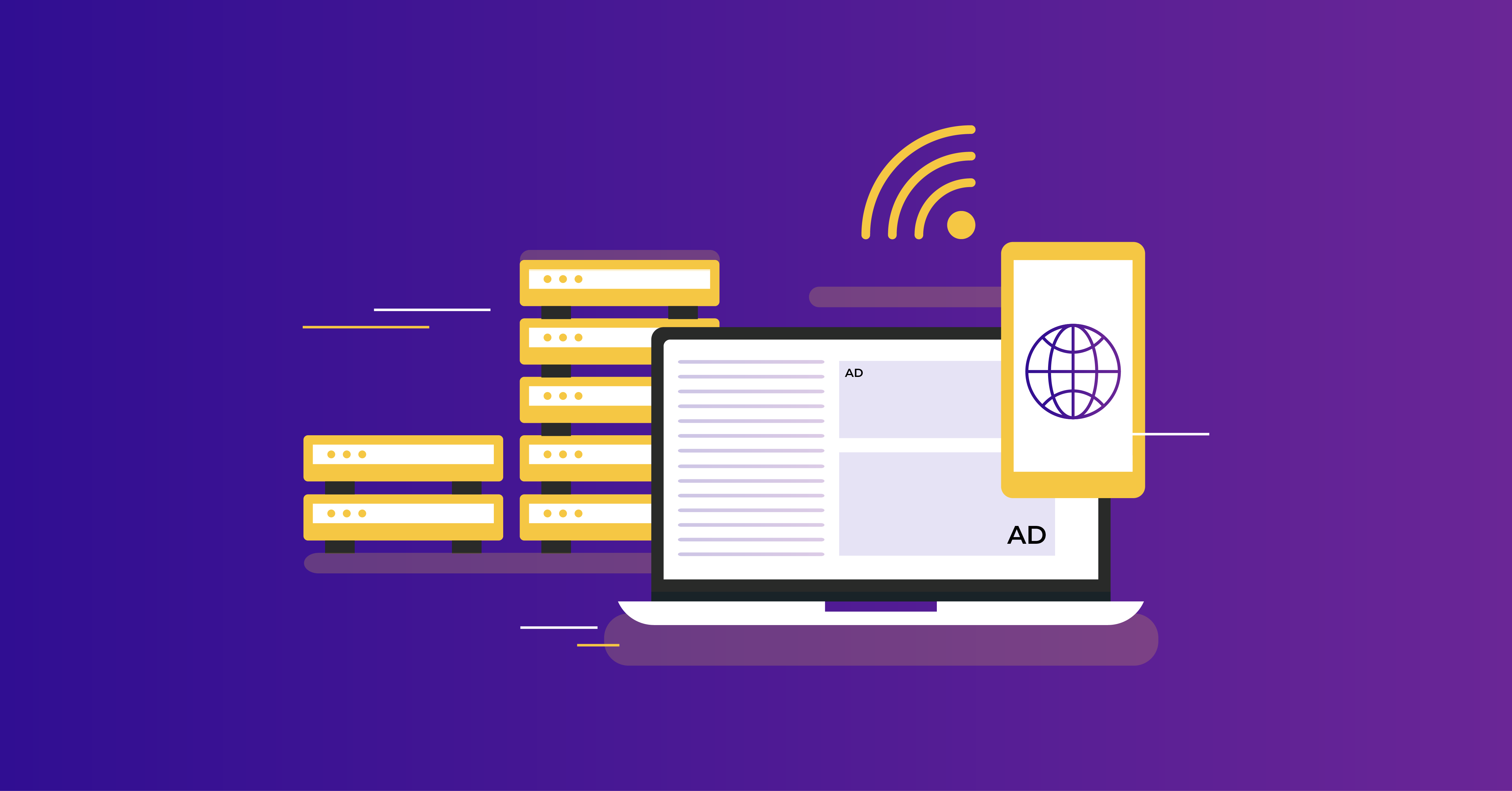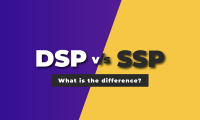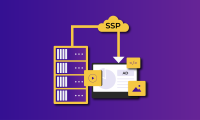Top 7 Ad Servers for Publishers- Benefits and Features
In the pre-ad server era, publishers have long grappled with the complexities and challenges of effectively managing ad campaigns. In traditional advertising, ad serving encompassed four major steps, each with its own set of sub-steps: marketplace negotiation, traffic management, measurement and optimization, and billing. With the adoption of ad servers, publishers gained the ability to execute these tasks that once took hours or days in a matter of seconds. This newfound efficiency allowed them to allocate their resources more strategically, focusing on revenue generation and enhancing overall campaign performance.
What is an ad server?
An ad server is a programmatic technology that helps deliver and manage ads on websites, mobile apps, or other digital platforms. It acts as a central hub that keeps track of different ads from various advertisers and ensures they are shown to the right people at the right time on publisher’s websites. It works seamlessly, coordinating the entire process of the programmatic display of ads.
Ad servers play a pivotal role in connecting advertisers and publishers through programmatic platforms, enabling efficient ad delivery. It is a central component that facilitates the programmatic buying and selling of digital ad inventory in real-time auctions. Here’s how an ad server works:
Advertisers use demand-side platforms (DSPs) to bid on ad inventory based on various targeting criteria, such as user demographics, interests, and browsing behavior. The ad server receives these bids from the DSPs and evaluates them in real-time auctions.
The ad server determines the winning bid based on predefined rules and parameters set by the publisher. It then communicates this information to the supply-side platform (SSP) connected to the publisher’s website or app. The SSP then delivers the winning ad to the user’s device, ensuring that the right ad is displayed to the right user at the right time.
How can publishers use ad servers?
Publishers can utilize ad servers to streamline, manage, and optimize their ad operations, ultimately maximizing their ad revenue. The integration of ad servers in programmatic platforms, such as ad networks, ad exchanges, and supply-side platforms (SSPs) valuable features and functionalities to publishers.
- Ad Networks
Ad networks aggregate ad inventory from multiple publishers and connect them with advertisers. Ad servers empower publishers within ad networks by centralizing ad management and delivery. Publishers can use an ad server to efficiently manage and rotate their ads across various ad network partners such as CPC ad networks, or video ad networks. The ad server ensures that the right ads are displayed to the right audience, taking their website monetization to the next level.
- Ad Exchanges
Ad exchanges facilitate the real-time buying and selling of ad impressions through auctions. Ad servers seamlessly integrate with top ad exchanges, enabling publishers to participate in these auctions and monetize their ad inventory effectively. This programmatic technology provides real-time bidding capabilities, allowing publishers to maximize the value of their impressions by connecting with demand-side platforms (DSPs) and receiving competitive bids from advertisers.
- SSPs (Supply-Side Platforms)
SSPs act as intermediaries between publishers and ad exchanges, optimizing the selling process for publishers. Ad servers integrate with SSPs to streamline the delivery of ad inventory. Publishers can use an ad server to set rules and parameters for ad serving, such as pricing, targeting, and frequency capping. Ad servers also provide reporting and analytics, allowing publishers to gain insights into ad performance and make data-driven decisions to enhance revenue generation.
What are the benefits of ad servers for publishers?
The benefits of ad servers for publishers are substantial. Here are the top 4 advantages of using ad servers for publishers:
- Centralized process
Ad servers provide a centralized platform for publishers to manage their entire ad ecosystem. Instead of dealing with multiple systems or interfaces, publishers can handle all their ad-related tasks, including ad scheduling, targeting, and reporting, from a single interface. This centralization streamlines workflow saves time, and reduces the complexity associated with managing ad campaigns across various channels or platforms.
- Bulk modifications for ad creatives
Managing a large number of ad creatives manually can be time-consuming and prone to errors. Ad servers offer bulk editing capabilities, allowing publishers to make changes to multiple ad creatives simultaneously. For example, publishers can quickly update targeting parameters, URLs, or creative elements across numerous ads with just a few clicks. This feature significantly speeds up the campaign management process and ensures consistency across ad sets.
- Automating daily tasks
Ad servers automate various daily tasks, relieving publishers from repetitive manual work. Tasks like ad rotation, ad scheduling, and frequency capping can be automated based on predefined rules and conditions. Publishers can set up specific criteria, and the ad server will handle the rest, ensuring ads are displayed at optimal times and frequency. Automation reduces human error, improves ad performance, and frees up publishers’ time for more strategic activities.
- Real-time data analysis
Ad servers provide real-time data analysis and reporting, empowering publishers with valuable insights into ad performance and user behavior. Publishers can access detailed metrics such as impressions, clicks, conversions, and revenue in real time. This immediate access to data allows publishers to monitor the effectiveness of their campaigns and make data-driven decisions promptly. Real-time data analysis enables publishers to optimize targeting, adjust budgets, and fine-tune ad strategies for better results and higher ad revenue.
Understanding how to choose the right ad server can greatly benefit publishers in their ad operations. Selecting an appropriate ad server involves considering factors such as functionality, scalability, reliability, and compatibility with existing systems.
Here are the top 10 ad servers for publishers to choose from using the above factors
DoubleClick for Publishers (DFP), now known as Google Ad Manager, is primarily an ad management platform and ad-serving solution for publishers. It is focused on providing ad serving tools for publishers to manage their own ad operations rather than functioning as a standalone ad network.
The DFP server has seamless integration and communication with Google’s ad networks, including Google AdSense and DoubleClick Ad Exchange. This integration allows publishers to access additional demand sources and monetization opportunities for their ad inventory.
OpenX is a versatile ad serving platform that offers both hosted and installed solutions. It provides various features and functionalities to publishers, making it an attractive choice, particularly for larger publishers, making it one of the best ad servers for walled gardens in programmatic advertising.
With OpenX, publishers can easily manage their inventory, target ads based on geographic location, and access detailed statistics for each ad placement. In addition to its ad serving capabilities, this ad sever also offers OpenAudience, a platform dedicated to audience management and it operates both a Supply-Side Platform (SSP) and a proprietary ad exchange.
Epom Ad Server is a highly flexible and powerful solution designed to meet the advertising needs of publishers across all industries. It serves as a robust foundation for publishers for all industries and sizes offering a range of features and benefits tailored to their requirements.
Epom Ad Server excels in cross-channel ad serving, allowing publishers to reach their target audience effectively across various devices. With advanced targeting options, publishers can access premium ad inventory and deliver their ad creatives to relevant users on mobile, desktop, video, in-app, and more.
Epom provides ad serving tools that offer automated CTR, conversion, and eCPM optimization, simplifying ad operations and allowing publishers to automate split testing directly within their accounts.
AdButler is primarily a display ad server however, it offers a comprehensive suite of features and solutions that cater to various advertising formats and channels, making it a powerful ad server for any publisher. It is ideal for online retailers, blogs, newspapers, community sites, and online forums.
One of the key advantages of AdButler is its instant analytics capabilities. Publishers can access real-time analytics without any delays. Additionally, AdButler offers easy campaign management tools, simplifying the process of setting up and managing advertising campaigns.
AdButler is also a self-serve marketplace that automates the ordering process for direct sales. It provides powerful APIs for building customized ad servers quickly, allowing for seamless integration and tailored solutions. The native ad server functionality enables publishers to serve ads that seamlessly blend with the look, feel, and function of the media format in which they appear.
Equativ, previously known as Smart AdServer, is a comprehensive ad management platform that combines the functionalities of both a Supply-Side Platform (SSP) and an ad server. This integrated platform empowers publishers by providing complete control over their vital assets, including data, audiences, and content.
With Equativ, publishers can optimize their revenue through holistic yield monetization and a unified auction system, ensuring the maximum value for every single impression. This approach helps publishers unlock the full potential of their inventory and maximize their advertising revenue.
Equativ prioritizes brand safety and ad quality control, offering robust measures to safeguard publisher content and ensure a high-quality ad experience for users. Real-time monitoring and stringent brand safety measures are implemented to maintain the integrity of the publisher’s brand and protect against harmful or inappropriate ads.
Adserver.Online is a robust cloud-based ad server and ad manager that offers much more than a typical ad server solution. It serves as a comprehensive product designed to cater to the needs of publishers, advertisers, agencies, and ad networks.
With Adserver.Online, users gain access to a powerful tool that simplifies the process of publishing advertising campaigns through a centralized dashboard. The platform enables publishers to enhance their pages with dynamic and interactive ads, providing advertisers with a wide range of possibilities to engage their target audience.
Adserver.Online streamlines ad management and ad publishing, making it incredibly convenient and efficient for users. By utilizing the platform’s user-friendly interface, users can easily handle all aspects of their advertising campaigns, ensuring a seamless experience for both publishers and advertisers.
Kevel offers publishers the flexibility to build or customize their own server-side ad server through the comprehensive Kevel API suite. By leveraging Kevel’s APIs, publishers can establish the core infrastructure for ad serving, targeting, and reporting, enabling them to bring their unique vision to life. Kevel’s APIs and SDKs provide the tools and resources necessary for seamless integration and development.
With Kevel, publishers can leverage first-party data to enhance their targeting capabilities, ensuring precise audience segmentation and personalized ad experiences. The platform enables publishers to create self-serve advertising portals, empowering advertisers to manage their campaigns directly.
Kevel’s support for both first and second price auctions allows publishers to optimize their revenue strategies. Additionally, the platform offers advanced targeting options, including city and geo-radius targeting, enabling publishers to reach their desired audiences with precision.
If publishers require full control over their ad operations, including direct relationships with demand sources and flexibility in optimization, choosing a dedicated ad server is a lucrative choice. With an ad server, publishers can negotiate terms, and control the types of ads displayed on their platforms. This direct approach fosters closer collaboration between publishers and advertisers, allowing for more targeted, relevant ad placements, and driving optimal results for their business.




Leave a Reply